Abstract
The Chemical Substances Control Act emphasizes the importance of proactive planning for chemical accident prevention and response, requiring facilities handling hazardous chemicals to develop and submit comprehensive plans in compliance with regulatory standards. Among these measures, the designation of chemical accident evacuation sites is considered a critical step to protect local residents and mitigate the impact of accidents. Despite the significance of evacuation site planning, existing research has primarily focused on the general conditions and locations of evacuation sites, with limited attention to their selection process and safety evaluation. This study aims to bridge this gap by evaluating the suitability of evacuation site locations through detailed risk assessments. Using tools such as KORA and ALOHA, the study analyzes the impact range under seasonal meteorological conditions. The limitations of current evacuation sites were assessed, and additional sites were proposed, considering the number of evacuees able to travel on foot during emergencies. The study highlights the importance of selecting evacuation sites based on seasonal weather conditions and provides actionable recommendations to improve public safety and minimize risks during chemical accidents. The findings of this study are expected to contribute to the advancement of emergency response systems, promoting a safer and more resilient environment for both local communities and industrial facilities.
1. Introduction
In September 2012, a hydrofluoric acid gas leak accident in Gumi caused the deaths of five workers at the site, along with reports of health issues among nearby residents and livestock fatalities, resulting in significant human and material damage [1,2,3]. Following the accident, ongoing research and national-level efforts were initiated to improve chemical accident responses, highlighting issues with emergency responses and identifying actions that required improvement [4,5]. This social backdrop prompted a comprehensive revision of the Chemical Substances Control Act, which included the implementation of regulations mandating the development of chemical accident prevention and management plans, as well as emergency response plans for chemical-handling facilities [6].
The chemical accident prevention and management plan aims to establish a community-level chemical accident response system by informing the local community about hazardous chemical information and emergency response measures implemented by facilities [7,8]. Evacuation sites, an essential notification element in the event of an accident, are critical for preventing casualties from chemical leaks and ensuring the safety of local residents. This is because chemical leaks have a significant impact on nearby businesses and residents [5,9]. Additionally, designating evacuation sites in advance can minimize confusion and facilitate prompt evacuations during chemical accidents. Based on this rationale, research into emergency evacuations during chemical accidents should be conducted. Furthermore, because wind direction has a significant impact on the dispersion and movement of chemical substances, rational safety measures should consider meteorological conditions [10].
To select suitable evacuation sites, an approach that considers wind direction and the surrounding geography is required, rather than relying on uniform site selection methods. The manual for drafting chemical accident prevention and management plans recommends designating at least two evacuation shelters in different directions based on the wind direction [11]. However, an analysis of ten current chemical accident evacuations revealed cases in which evacuation shelters were uniformly designated in the same direction. To reduce casualties in chemical accidents, it is essential to select evacuation shelters that reflect seasonal weather conditions and wind direction patterns.
Previous research on chemical accidents has primarily focused on technical and managerial prevention measures, as well as legal or institutional improvements to prevent accidents [12,13,14,15,16]. Although studies on accident response and community safety have been conducted, they have primarily focused on target selection, effective notification methods, and strategies to enhance public notification [17,18,19,20,21,22,23].
While existing studies on evacuation site selection consider wind direction, comprehensive research incorporating seasonal weather conditions and wind patterns to determine the best locations for evacuation during chemical accidents is still lacking [4,24,25,26,27,28].
This study reviews current chemical accident evacuation sites to determine whether they are appropriately located and capable of protecting local residents by considering meteorological conditions such as wind direction and speed. Furthermore, additional evacuation sites have been proposed as part of the improvement measure. The results and proposed improvements from this study are expected to contribute to strengthening emergency response systems during chemical accidents.
2. Theoretical Background and Methods
2.1. Related System
The community notification system under the Chemical Accident Prevention and Management Plan was designed to ensure the safety of local residents and enable a prompt response in the event of a chemical accident by providing the local community with information related to chemicals handled by facilities [7,8,11].
The workflow of the Chemical Accident Prevention and Management Plan is shown in Figure 1. The purpose of this system is to provide local residents with information on the types and quantities of hazardous chemicals handled by nearby facilities, as well as response plans in the event of an accident, so that they can plan for potential risks. Certain details are disclosed to the community to achieve this goal. The disclosed information includes facility details, a list of hazardous chemicals and their key hazards, the overall impact range of accident scenarios, emergency contact systems, methods for issuing evacuation alerts, and designated evacuation sites and procedures during accidents.
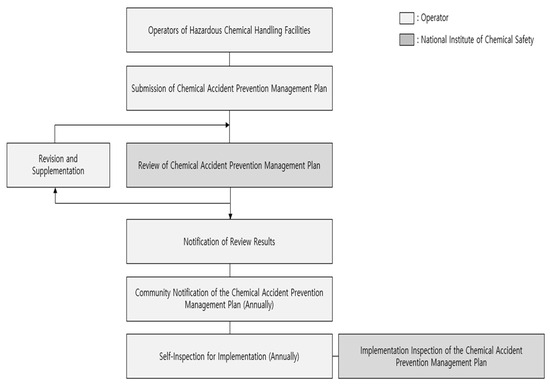
Figure 1.
Procedures for the chemical accident prevention management plan (operator-centered).
Among the information disclosed, evacuation sites play an important role in ensuring the safety of residents during a chemical spill.
When selecting evacuation sites for chemical accidents, it is recommended to designate at least two sites considering wind direction [11]. This is because hazardous chemicals can spread along the wind during chemical accidents, and providing evacuation sites in multiple directions ensures that residents can evacuate safely. However, an analysis of evacuation sites designated for 10 facilities revealed that the evacuation sites were uniformly designated in the same direction, as summarized in Table 1.

Table 1.
Analysis of current chemical accident shelter locations.
2.2. Selection of Target Substances
Approximately 40,000 chemical substances are currently used in South Korea, and their variety and applications are continuously expanding [29,30].
Among them, the number of facilities handling styrene monomers has significantly increased, from 1191 in 2014 to 1673 in 2020, due to the rising demand for chemical products such as plastics and synthetic rubber (Figure 2) [31]. Styrene monomers are produced through the reaction of ethylene and benzene, in which ethylbenzene is oxidized and dehydrogenated to form styrene, followed by polymerization initiated by various initiators. The heat of polymerization generated during this process is approximately 16.7 kcal/mol, and if the exothermic reaction is not adequately controlled, there is a risk of explosion at high temperatures. In particular, styrene monomers react with oxygen in the air during oxidation, releasing heat and light, which increases the risk of fire and explosion. Overexposure can cause skin and respiratory irritation, leading to health issues. Additionally, styrene is a volatile organic compound (VOC) that rapidly evaporates into the atmosphere, contributing to environmental pollution.
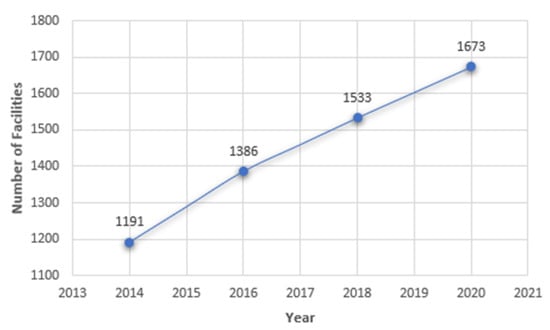
Figure 2.
Facility trend of styrene monomer-handling companies.
Therefore, this study selected styrene monomer as the target substance due to its increasing usage and inherent risk of explosion.
2.3. Major Accident Cases Involving Styrene Monomer
Styrene monomer has seen a global increase in handling volume due to the rising demand for chemical products such as plastics and synthetic rubber. It is a particularly high-risk substance prone to accidents caused by polymerization reactions and temperature control failures. To better understand the risks associated with styrene monomer, domestic and international accident cases were investigated.
In May 2020, a styrene monomer leak from a storage tank at a factory in southern India resulted in 13 deaths and the hospitalization of approximately 1000 people. The causes were attributed to poor design, malfunctioning alarms, and ignored warnings [32,33]. In May 2019, a leak occurred during refining at the Daesan SM plant in South Korea. Prolonged storage of high-concentration styrene mixtures causes polymerization inhibitor deactivation, which accelerates self-polymerization [34,35,36]. In August 2011, runaway polymerization occurred during a trial run after maintenance in Nam-gu, Ulsan, causing injuries and severe equipment damage. The causes included temperature control failure and delayed ethylbenzene injection [37,38]. In August 2005, a styrene leak from a railroad tank car in Cincinnati, Ohio, caused evacuations within a 0.5 mi radius and temporarily closed an airport due to pressure buildup from a polymerization reaction [39,40].
Repeated styrene monomer leak accidents in South Korea, the United States, India, and other parts of the world highlight common issues, such as polymerization reactions and temperature control failures. These accidents underscore the importance of implementing strict safety and management measures (Table 2).

Table 2.
Styrene monomer accident cases.
2.4. KORA and ALOHA
Facilities utilize the Korea Offsite Risk Assessment Support tool (KORA) to select evacuation sites in the event of a chemical accident (version 5, National Institute of Chemical Safety, Cheongju, Republic of Korea). KORA evaluates the impact range of potential fires, explosions, and toxic dispersion accidents from handling facilities, while also analyzing accident frequency to calculate the risk level of accident scenarios [41,42]. However, KORA does not account for wind direction or variations in meteorological conditions over time, providing only fixed, uniform impact ranges. As a result, it has limitations in selecting evacuation sites that consider seasonal weather characteristics and wind direction. To address this, this study additionally employed the ALOHA (Area Locations of Hazardous Atmospheres) program (version 5.4.7, NOAA and EPA, USA). ALOHA incorporates real-time meteorological conditions such as wind direction, wind speed, temperature, and humidity to simulate hazardous material dispersion and is widely used globally for chemical accident prevention and response planning [43].
2.4.1. Target Process
As shown in Figure 3, the styrene monomer process involves multiple stages of chemical reactions and purification steps to produce the final styrene monomer [44]. Each stage has a potential risk factor [45].

Figure 3.
Process flow.
In the alkylation process that produces ethylbenzene (EB), ethylene reacts with benzene. EB purification and trans-alkylation processes then refine the produced ethylbenzene and recover the byproducts. Subsequently, the process advances to the dehydrogenation reaction stage, in which ethylbenzene is converted into a styrene monomer. Finally, in the SM purification process, unreacted materials, impurities, and byproducts are removed from the styrene monomer.
2.4.2. Meteorological Conditions
As shown in Table 3, the seasonal weather conditions for 10 years in the area where the target facility is located were analyzed and shown in Figure 4. The average temperature in spring (March to May) was 12.68 °C and the average humidity was 12.68 °C. 77.57%, the average southeasterly wind speed is 2.13 m/s. During summer (June to August), the average temperature is 26.66 °C, with an average humidity of 91.43% and an average wind speed of 2.17 m/s with southwesterly winds. During fall (September to November), the average temperature is 15.92 °C, with an average humidity of 85.43% and an average wind speed of 1.86 m/s with northeasterly winds. During winter (December to February), the average temperature is 0.2 °C, with an average humidity of 79.67% and an average wind speed of 2.15 m/s with westerly winds [46].

Table 3.
Seasonal weather conditions.
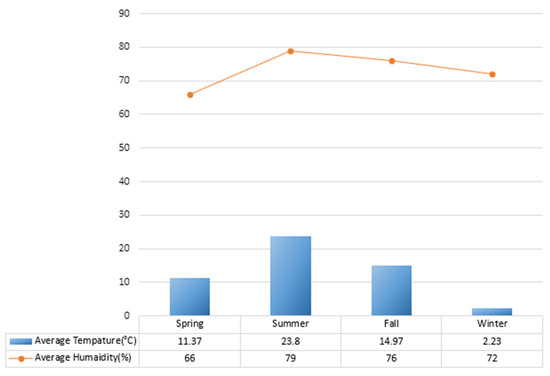
Figure 4.
Meteorological conditions of the target area (2013–2023).
2.4.3. Accident Scenario
The accident scenario assumed a styrene monomer leak caused by an abnormal polymerization reaction of unknown origin inside a mixed residue oil storage tank at a styrene monomer plant [37,38,39]. This scenario was based on the conditions of the styrene monomer leak incident that occurred in 2019, with the meteorological conditions derived from an analysis of ten years of weather data for the region where the target facility was located. A summary of the accident scenarios is provided in Table 4.

Table 4.
Input data.
3. Results
3.1. Chemical Accident Evacuation Sites
An investigation of the chemical accident evacuation sites in Facility A revealed that, as shown in Figure 5, four chemical accident evacuation sites have been designated. However, all four evacuation sites are located in the southeast, with the minimum distance between the facility (potential accident site) and the evacuation sites being 6.4 km (Table 5). In the event of an accident involving the tank storing a large quantity of styrene monomer, there is a risk of exposure to hazardous chemicals for facility workers or nearby residents during winter when northwesterly winds prevail. Therefore, additional evacuation sites must be designated, considering the seasonal wind patterns.
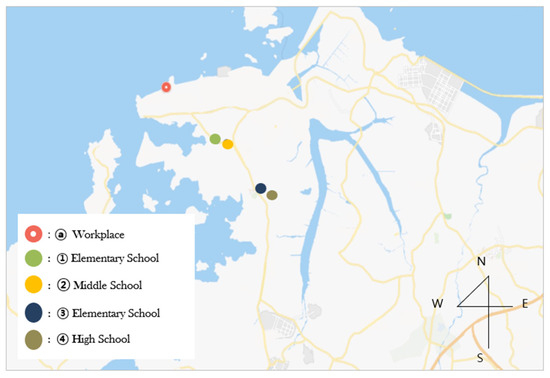
Figure 5.
Chemical accident evacuation site at a facility.

Table 5.
Locations of chemical accident evacuation sites.
3.2. Damage Prediction Results
The analysis of the impact range of chemical accidents using KORA revealed an impact radius of 642.7 m and an off-site distance of 590.3 m. However, as shown in Figure 6, KORA only provides uniform ranges without considering wind direction.
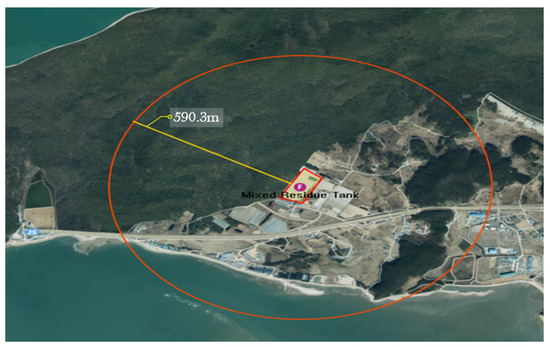
Figure 6.
Impact Range in Case of an Accident.
ALOHA was used to overcome these limitations. The analysis results, as shown in Figure 7, indicated that during spring, chemical substances spread westward and northwestward under the influence of southeasterly winds. During summer, they spread northward and northwestward due to southwesterly winds. In autumn, they dispersed southward under the influence of northeasterly winds, and in winter, they spread eastward owing to westerly winds.
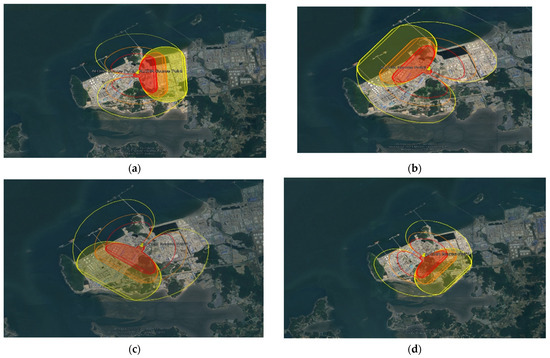
Figure 7.
ALOHA analysis results. (a) Spring; (b) Summer; (c) Spring; (d) Summer.
These results show that the direction of chemical dispersion varies based on the seasonal winds. The currently designated chemical accident evacuation sites located in the southeast are considered appropriate because of the geographic characteristics of the mountains and seas to the west and north, which restrict evacuation in these directions.
However, evacuation toward the southwest and east is feasible, suggesting the potential for selecting additional evacuation sites. In addition, the minimum distance between the designated evacuation sites and the accident site was 6.4 km, which may pose challenges for on-foot evacuation by facility workers or nearby residents. Therefore, additional evacuation sites must be designated, considering the wind direction and feasibility of on-foot evacuation.
3.3. Improvement Measures
Wind direction and speed are the key factors in determining the direction and rate of hazardous material dispersal during a chemical accident. During summer, southwesterly winds were predominant at higher wind speeds, while northwesterly winds prevailed in the winter with lower wind speeds. These seasonal meteorological conditions significantly impact the dispersion range and affect areas of hazardous substances.
In this study, the correlation between meteorological conditions and chemical accidents was analyzed using the ALOHA software (version 5.4.7), confirming that affected areas vary by season. Based on these results, seasonal evacuation sites were proposed, taking into account meteorological factors such as wind direction and speed, as well as the number of evacuees traveling on foot. The comparison of current evacuation sites with additional proposed sites is summarized in Table 6, and their locations are shown in Figure 8.

Table 6.
Locations and distances of chemical accident shelters.
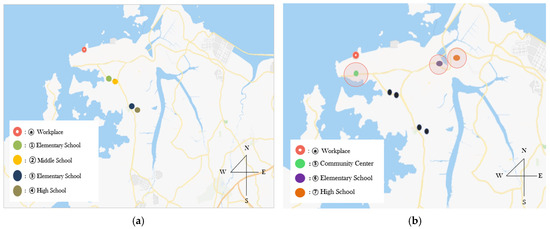
Figure 8.
Current and improved chemical accident evacuation sites. (a) Current evacuation sites. (b) Additional evacuation sites.
4. Conclusions
Evacuation sites play a crucial role in protecting people from the dispersion of hazardous chemicals and secondary damage. Since the dispersion path and range of hazardous substances vary depending on meteorological conditions such as wind direction and speed, evacuation sites must be carefully selected to ensure that evacuees are not exposed to these dispersion paths. Current regulations require the designation of at least two evacuation sites, taking wind direction into account, when selecting evacuation locations for chemical accidents. However, an analysis of evacuation sites reported by 10 facilities revealed that most sites were uniformly designated without adequately considering wind direction.
To address these issues, this study proposes evacuation site selection methods that consider seasonal wind direction and the feasibility of on-foot evacuation. An analysis of chemical accident evacuation sites at the target facility revealed that all currently designated evacuation sites are located in the southeast. This increases the risk of exposure to hazardous chemicals during the winter, when southwesterly winds are predominant. Using KORA to evaluate the impact range and ALOHA to analyze the impact range while considering wind direction, it was confirmed that the areas at risk of chemical dispersion vary by season. Additionally, the minimum distance from the accident site to the currently designated evacuation sites was found to be 6.4 km, presenting practical challenges for on-foot evacuation by workers or nearby residents.
In this study, additional evacuation sites were proposed, including one located 1.4 km away and others in the east and south, taking into account seasonal wind patterns. Currently, evacuation site selection guidelines suggest locating sites in the upwind direction of the accident site, considering immediate wind conditions. However, as proposed in this study, it is necessary to select evacuation sites that also account for seasonal wind patterns, ensuring the safety of evacuees under varying meteorological conditions. This highlights the importance of selecting evacuation sites based on seasonal wind direction and the feasibility of on-foot evacuation.
While this study considered seasonal wind patterns, it did not account for sudden and unpredictable weather changes. Furthermore, the proposed evacuation sites were based on the seasonal and geographical conditions specific to the target region, making it challenging to generalize the findings to facilities with unique geographical, meteorological, or operational conditions. However, for facilities with typical geographical and meteorological conditions, establishing evacuation sites that consider seasonal wind patterns, as proposed in this study, could facilitate prompt and safe evacuations during chemical accidents. Moreover, adopting the evacuation site selection methods proposed in this study is expected to effectively minimize secondary damage, even as areas of concern for chemical accident impacts shift due to seasonal wind pattern changes.
Author Contributions
Methodology, C.K.; validation, Y.C.; resources, M.N., Y.C. and C.K.; writing—original draft, M.N.; writing—review and editing, B.Y.; supervision, B.Y. All authors have read and agreed to the published version of the manuscript.
Funding
This research was supported by the Korea Institute of Industrial Technology Evaluation and Planning (Project No. 202302850002) and this research was supported by the Korea Institute of Energy Technology Evaluation and Planning (KETEP) and the Ministry of Trade, Industry and Energy (MOTIE) of the Republic of Korea (Project No. 20227310100060).
Data Availability Statement
The original contributions presented in this study are included in the article. Further inquiries can be directed to the corresponding authors.
Conflicts of Interest
The authors declare no conflict of interest.
References
- Kim, J.H.; Jeong, C.; Kang, S.M.; Yong, J.-W.; Yoo, B.; Seo, J.M. Comparative assessment of damage impact range prediction models through a case study of the Gumi hydrofluoric acid accident. J. Korean Inst. Chem. Eng. 2017, 55, 48–53. [Google Scholar]
- Cha, S.Y.; Im, T.B. Study on disaster management system: Case study using social network analysis on hydrofluoric acid leakage accident in Gumi, Korea. J. Local Gov. Stud. 2014, 18, 727–754. [Google Scholar]
- An, J.S.; Lee, H.A.; Lee, J.S.; Yoon, H.O. Fluorine distribution in soil in the vicinity of an accidental spillage of hydrofluoric acid in Korea. Chemosphere 2015, 119, 577e582. [Google Scholar] [CrossRef] [PubMed]
- Byung-Chul, L. Manufacturing process and quality control of expanded polystyrene. J. Korean Geotech. Soc. 1994, 1994, 33–51. [Google Scholar]
- Bang, M.; Chon, Y.; Hwang, Y.; Lee, I. A study on the integrated analysis of chemical accidents by using the decision tree. Korean J. Hazard. Mater. 2017, 5, 59–66. [Google Scholar]
- Jung, Y.K.; Lee, M.J.; Heo, H.J.; Park, J.D.; Yoon, J.H. A study on the way to revitalize resident notification system of hazardous chemicals. Crisisonomy 2018, 14, 41–50. [Google Scholar] [CrossRef]
- Republic of Korea. Article 23-3. In Chemical Substances Control Act; Korean Law Translation Center: Sejong, Republic of Korea, 2021. [Google Scholar]
- Republic of Korea. Article 19-4. In Enforcement Rules of the Chemical Substances; Food and Agriculture Organization: Rome, Italy, 2021. [Google Scholar]
- Hwang, M.; Hwang, Y.; Lee, I.; Min, D. A study on the advancement of the contingency plan upon prediction of toxicity damage considering seasonal characteristics. J. Korean Soc. Disaster Secur. 2016, 9, 23–32. [Google Scholar] [CrossRef]
- Kim, S.; Kwak, D.; Jeon, J.; Jeong, S. A study on the contribution to reducing chemical accident of joint inter-agency chemical emergency preparedness center. J. Chem. Saf. 2023, 12, 45–56. [Google Scholar]
- Yoo, B.T. A study on improvement safety management through chemical accident investigations. J. Soc. Disaster Inf. 2021, 17, 403–414. [Google Scholar]
- Ahn, S.-Y.; Kim, J.-Y.; Kim, S.-B.; Chun, K.-G.; Lee, J.-S.; Park, C.-H. The chemical reactivity of detecting tube detection equipment for incident responder. J. Soc. Disaster Inf. 2014, 10, 33–39. [Google Scholar]
- Phark, C.; Kim, S.; Jung, S. Development to Emergency Evacuation Decision Making in Hazardous Materials Incidents Using Machine Learning. Processes 2022, 10, 1046. [Google Scholar] [CrossRef]
- Oh, J.-Y. Study on the Establishment of an Integrated System to Support Decision-Making for Resident Evacuation within the Impact Area of Chemical Accidents. Ph.D. Thesis, Graduate School of Pusan National University, Busan, Republic of Korea, 2024. [Google Scholar]
- Lee, S.G.; Kim, E.H.; Ma, B.C. Monitoring chemical accidents in industrial complexes using tower-installed infrared system for remote chemical detection and long-range video surveillance system. Appl. Sci. 2023, 13, 1544. [Google Scholar] [CrossRef]
- Lee, J.; Ma, B. An operator training simulator to enable responses to chemical accidents through mutual cooperation between the participants. Appl. Sci. 2023, 13, 1382. [Google Scholar] [CrossRef]
- Choi, M.; Jo, S. New developments in detector and bund wall standards to mitigate the risk of hazardous liquid leaks. Processes 2023, 11, 3179. [Google Scholar] [CrossRef]
- Jeon, B.-H.; Kim, H.-S.; Lee, M.-J.; Yun, J.-H.; Jung, W.-Y.; Oh, S.-B. Development of a Damage Impact Distance Calculation Formula for Accident Response and Prevention in Case of Leakage of Substances Prepared for Evacuation of Residents in Chungju. J. Korea Acad.-Ind. Coop. Soc. 2021, 22, 703–712. [Google Scholar]
- Lee, S.; Park, J. A study on the selection criteria for compliance inspection targets in chemical accident prevention management plans. J. Ind. Saf. Chem. Manag. 2020, 25, 112–120. [Google Scholar]
- Kim, H.; Choi, M. Analysis on resident notification preferences for chemical accident prevention plans. Environ. Saf. J. 2019, 19, 45–52. [Google Scholar]
- Kim, J.; Lee, S.; Park, H. Improving public notification systems for hazardous chemicals: Strategies and challenges. J. Saf. Commun. 2018, 21, 30–38. [Google Scholar]
- Jeong, H.; Lee, T. A comparative study on the effectiveness of public notification systems: Lessons from COMAH. J. Chem. Hazard Prev. 2019, 33, 92–100. [Google Scholar]
- Smith, J.; Doe, A. The role of chemical monitoring and public alert systems in hazard mitigation. J. Environ. Saf. 2020, 25, 115–124. [Google Scholar]
- Lee, M.; Park, K. Development of a risk assessment indicator system for industrial chemical complexes. Int. J. Environ. Res. Public Health 2019, 17, 5578. [Google Scholar]
- Wang, L.; Chen, Y. Urban emergency evacuation path optimization based on uncertain environments to improve resilience. Symmetry 2023, 16, 1356. [Google Scholar]
- Liu, Z.; Zhou, X. An analysis of pedestrians’ behavior in emergency evacuation using cellular automata simulation. arXiv 2019, arXiv:1903.01229. [Google Scholar]
- Kim, S.; Yang, J. Using virtual reality to simulate human-robot emergency evacuation scenarios. arXiv 2022, arXiv:2210.08414. [Google Scholar]
- Kim, B.; Seo, M.; Kim, K.; Eo, Y.; Chun, Y. A study on the reasonable selection method of shelter in the event of chemical accident. J. Korean Inst. Hazard. Mater. 2019, 7, 90–100. [Google Scholar] [CrossRef]
- Kim, M. A study on the evaluation method for selecting indoor shelter areas in response to chemical accidents. J. Korean Inst. Hazard. Mater. 2018, 6, 45–55. [Google Scholar]
- Statistics Korea. Current Status of Chemical Substances and Management in Korea; Statistics Korea: Daejeon, Republic of Korea, 2021. [Google Scholar]
- National Institute of Chemical Safety (NICS). Comprehensive Chemical Information System, Chemical Substance Statistical Information Disclosure; National Institute of Chemical Safety (NICS): Cheongju, Republic of Korea, 2024. [Google Scholar]
- Wang, J.; Zhang, H.; Li, Y. Emergency evacuation planning for chemical incidents using multi-objective optimization. Process Saf. Environ. Prot. 2015, 98, 60–70. [Google Scholar]
- Tun, E.; Toshimitsu, N.; Varun, V.; Makoto, C.; Miho, S.; Akimasa, F. Emergency shelter location–allocation analysis with time-varying demand. Asian Transp. Stud. 2024, 10, 100152. [Google Scholar] [CrossRef]
- Young-Hoon, O. Analysis of the Causes of Polymerization Phenomena in Styrene Monomer Storage Tanks. Master’s Thesis, Graduate School of Engineering Practice, Seoul National University, Seoul, Republic of Korea, 2021. [Google Scholar]
- Kim, K.W.; Park, J.W.; Jeong, M.S. Association between communication for chemical hazards information and characteristics of occupational safety and health manager. J. Korean Soc. Occup. Environ. Hyg. 2012, 22, 156–163. [Google Scholar]
- National Institute of Chemical Safety. Chemical Distribution Volume; National Institute of Chemical Safety: Cheongju, Republic of Korea, 2024. [Google Scholar]
- 12 Dead in India LG Factory Gas Leak. Chosun Ilbo, 8 May 2020.
- Twelve Lives Lost in the Indian LG Polymers Factory Gas Leak. Pressian, 8 May 2020.
- Chemical Accident: Shocking and Fatal Scenes. Pressian, 5 June 2019.
- ’Vapor Leakage’ Accident: Substance Meant for Cold Storage Kept in Heated Tank. Hankyoreh, 20 May 2019.
- Kwak, S.; Lim, H.J.; Ryu, T.K.; Choi, W.S.; Jeong, J.H.; Lee, J.E.; Kim, J.G.; Lee, Y.H.; Ryu, J.S.; Yoon, J.H.; et al. Assessment of the Impact Range Changes According to the Operating Conditions of Chlorine Handling Facilities in Water Treatment Plants Using KORA; National Institute of Chemical Safety, Accident Prevention and Review Division and R&D Education Division: Cheongju, Republic of Korea, 2018. [Google Scholar]
- Kim, J.K.; Ryu, J.S.; Ryu, T.K.; Kwak, S.L.; Lim, H.J.; Choi, W.S.; Jeong, J.H.; Lee, J.E.; Lim, D.Y.; Yoon, J.H. Suggestions for Increasing Utilization of KORA for Supporting the Off-site Risk Assessment System. J. Environ. Health Sci. 2018, 44, 124–132. [Google Scholar]
- Son, T.E. Dispersion Model Study for Estimating the Initial Impact Range of Chemical Substance Leakage. Master’s Thesis, Department of Safety Engineering, Pukyong National University, Busan, Republic of Korea, February 2021. [Google Scholar]
- Korea Occupational Safety and Health Agency. Styrene Monomer (SM) Safety Guide; Korea Occupational Safety and Health Agency: Ulsan, Republic of Korea, 2019. [Google Scholar]
- Choi, H.-S.; Choi, H.-S.; Choi, M.-J.; Cho, G.-S. Analysis of damage prediction for styrene monomer fire and explosion accident. J. Korean Soc. Saf. 2024, 9, 37–44. [Google Scholar] [CrossRef]
- Korea Meteorological Administration (KMA). Weather Data Open Portal: ASOS (Automated Synoptic Observing System) Real-Time Data [Online Database]; Korea Meteorological Administration (KMA): Seoul, Republic of Korea, 2024. [Google Scholar]
Disclaimer/Publisher’s Note: The statements, opinions and data contained in all publications are solely those of the individual author(s) and contributor(s) and not of MDPI and/or the editor(s). MDPI and/or the editor(s) disclaim responsibility for any injury to people or property resulting from any ideas, methods, instructions or products referred to in the content. |
© 2025 by the authors. Licensee MDPI, Basel, Switzerland. This article is an open access article distributed under the terms and conditions of the Creative Commons Attribution (CC BY) license (https://creativecommons.org/licenses/by/4.0/).